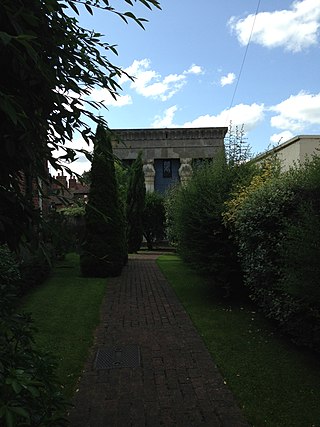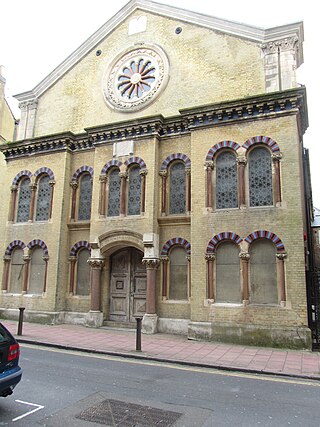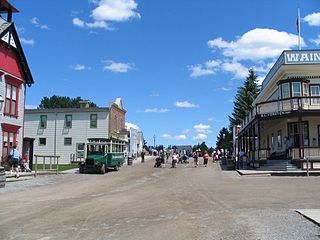
Synagogue architecture often follows styles in vogue at the place and time of construction. There is no set blueprint for synagogues and the architectural shapes and interior designs of synagogues vary greatly. According to tradition, the Shekhinah or divine presence can be found wherever there is a minyan, a quorum, of ten. A synagogue always contains an Torah ark where the Torah scrolls are kept, called the aron qodesh by Ashkenazi Jews and the hekhal by Sephardic Jews.

Bevis Marks Synagogue, officially Qahal Kadosh Sha'ar ha-Shamayim, is an Orthodox Jewish congregation and synagogue, located off Bevis Marks, Aldgate, in the City of London, England, in the United Kingdom. The congregation is affiliated to London's historic Spanish and Portuguese Jewish community and worships in the Sephardic rite.

The Great Synagogue of London was a former Orthodox Jewish congregation and synagogue, located in the City of London, England, in the United Kingdom. The synagogue was, for centuries, the centre of Ashkenazi life in London. Built north of Aldgate in the 17th century, it was destroyed during World War II, in the Blitz.

Ramsgate is a seaside town in the district of Thanet in east Kent, England, with a population of 39,639 in the '2001 UK Census. It was one of the great English seaside towns of the 19th century. Ramsgate's main attraction is its coastline, and its main industries are tourism and fishing. The town has one of the largest marinas on the English south coast, and the Port of Ramsgate provided cross-channel ferries for many years.

Heaton Park Hebrew Congregation is a large Ashkenazi Orthodox synagogue located in North Manchester, United Kingdom. It was founded in 1935, and in 2010 had between 500 and 749 members. Under the aegis of the Chief Rabbi of the United Kingdom, Reverend Leslie Olsberg MBE led the congregation for 35 years until his death in 2008. Rabbi Daniel Walker succeeded him, and currently heads the congregation. Yehuda Marx is the hazzan.

The Old Synagogue in Canterbury is considered to be the best example of an Egyptian Revival synagogue.
David Alfred Mocatta (1806–1882) was a British architect and a member of the Anglo-Jewish Mocatta family.

The Montefiore Windmill is a landmark windmill in Jerusalem. Designed as a flour mill, it was built in 1857 on a slope opposite the western city walls of Jerusalem, where three years later the new Jewish neighbourhood of Mishkenot Sha'ananim was erected, both by the efforts of British Jewish banker and philanthropist Moses Montefiore. Jerusalem at the time was part of Ottoman-ruled Palestine. Today the windmill serves as a small museum dedicated to the achievements of Montefiore. It was restored in 2012 with a new cap and sails in the style of the originals. The mill can turn in the wind.

The Middle Street Synagogue is a synagogue in the centre of Brighton, part of the English city of Brighton and Hove. It was the centre for Jewish worship in Brighton and Hove for more than a century. Although it is not in full-time use, the building is still open at certain times, and cultural events frequently take place, as do weddings. It has been listed at Grade II*, reflecting its architectural and historic importance.

The Little Synagogue on the Prairie is a small, wooden synagogue originally built in Sibbald, Alberta, just west of the Alberta-Saskatchewan border. Originally called the Montefiore Institute, it was built in 1913 or 1916 by the Montefiore colony of Jewish immigrants who had settled in Alberta in 1910, named after Sir Moses Montefiore. It is one of the few surviving examples of the small, wooden synagogues that were built by pioneers on the Canadian and American prairie.

The Sassoon Mausoleum is the former grave of Sir Albert Sassoon and other members of his family, including Sir Edward Sassoon, 2nd Baronet, of Kensington Gore. It stands at 83 St. George's Road in Brighton, England. The single-storey building, which is Grade II listed, has since served as a furniture depository and an air-raid shelter, and since being purchased by a brewery in 1949 has remained a pub or bar.

The Cheltenham Synagogue is a synagogue in Cheltenham and is noted for its Regency architecture. It is an independent congregation located in the town centre on Synagogue Lane, off St James's Square.

The Plymouth Synagogue is a synagogue in the city of Plymouth, England and the home of the Plymouth Hebrew Congregation. Built in 1762, it is a listed Grade II* building and the oldest extant synagogue built by Ashkenazi Jews in the English speaking world.

Sir Moses Haim Montefiore, 1st Baronet, was a British financier and banker, activist, philanthropist and Sheriff of London. Born to an Italian Sephardic Jewish family based in London, after he achieved success, he donated large sums of money to promote industry, business, economic development, education and health among the Jewish community in the Levant. He founded Mishkenot Sha'ananim in 1860, the first Jewish settlement outside the Old City of Jerusalem.

Judith, Lady Montefiore was a British linguist, musician, travel writer, and philanthropist. She was the wife of Sir Moses Montefiore. She authored the first Jewish cook book written in English.

Louis Loewe was a Silesian linguist. He served as principal and director of Judith Theological College for twenty years; he was a member of the Royal Asiatic Society, Numismatic Society and of the Asiatic Society of Paris.
Judith Lady Montefiore College is a Jewish theological seminary founded in 1869 by Sir Moses Montefiore in memory of his late wife, Lady Judith Montefiore, at Ramsgate, Kent. Though closed in 1985, the College re-opened in London in 2005.

The Lauderdale Road Spanish & Portuguese Synagogue, more commonly called the Lauderdale Road Synagogue, is an Orthodox Jewish congregation and synagogue, located in Maida Vale on Lauderdale Road in the City of Westminster, West London, England, in the United Kingdom.

















